Comments / Questions (127)
![]() Stella Alvarez Arenas wrote:
Stella Alvarez Arenas wrote:
Bei den Raglanzunahmen für die Ärmel müssten doch insgesamt 20x Maschen zugenommen werden, wenn man von 21 Maschen pro Ärmel auf 61 kommen sollte. Oder liege ich falsch?
14.11.2025 - 13:57DROPS Design answered:
Liebe Frau Alvarez Arenas, in den 61 Maschen sind die 2 Maschen vom Raglan damit gerechnet, so 21 Maschen + 2 Maschen beidseitig + 18Mal 2 Maschen zugenommen = 61 Maschen. Viel Spaß beim Stricken!
14.11.2025 - 16:22
![]() Johanne Francoeur wrote:
Johanne Francoeur wrote:
Bonjour, je suis présentement bloquée sur ce modèle, sur le début du diagramme, en continuant le raglan manches, il est indiqué tric 7X A2 (donc 14 m bleues ?) ensuite les 8 m de A1 et 1 m de A1 etc. Mais je vois que ça forme des lignes bleues alors que ça devrait être les pointes du triangle sur la photo du modèle ? Aussi je me demande, comme je commence le tour avec le raglan, je fais le raglan en bleu ? Là j’avoue que je suis un peu mélangée… Merci de me répondre.
22.09.2025 - 19:54DROPS Design answered:
Bonjour Mme Francoeur, les mailles de A.2 ne sont tricotées qu'une seule fois en largeur et 4 fois au total car ce sont les mailles des raglans, c'est A.1 que vous allez répéter, 7 fois dans les taille 2 à 6soit 56 mailles du motif A.1. Les mailles des raglans se tricotent en suivant les rayures indiquées dans le diagramme. Bon tricot!
24.09.2025 - 08:22
![]() Bettina wrote:
Bettina wrote:
Jeg er ved at strikke Drops nr. U-765 til min søn. Jeg skal nu til mønsteret. I opskriften står der: A2 - A1x7 - 1.m A1 (2+56+1 =59) Men ovenover er der taget ud til 61 m. på ærmet!?!? Hvor skal jeg starte for at det kommer til at passe? Eller hvad gør jeg med de to sidste masker? Håber i kan hjælpe 🙏
02.06.2025 - 14:55DROPS Design answered:
Hej Bettina, hvilken størrelse strikker du og hvor mange masker har du totalt, så skal vi se om det stemmer :)
03.06.2025 - 07:53
![]() Tanja wrote:
Tanja wrote:
Hallo, ich habe die ersten Zunahmen gestrickt und habe jetzt 300 Maschen auf der Nadel für Größe XL, die Arbeit ist insgesamt 9 cm lang. Jetzt soll ich laut Anleitung schon mit dem Muster beginnen, das Foto zeigt aber einen großen Teil in weiß gestrickt, bevor das Muster beginnt. Muss ich jetzt nicht erst weitere Zunahmen ohne Muster arbeiten? Wieviele Runden oder Zunahmen sind erforderlich, bevor das Muster einsetzt?
23.04.2025 - 10:03DROPS Design answered:
Liebe Tanja, stimmt Ihre Maschenprobe in der Höhe? Für den Raglan strickt man insgesamt 34 Reihen (Rumpf: 10x in jeder Runde + 12 x in jeder 2. Runde und Ärmel: 17 x in jeder 2. Runde) so ca 12 cm + die vorigen Runde - so können Sie entweder diesen Teil je nach Ihrer Maschenprobe umrechnen oder mit natur bis ca 12 cm weiterstricken und dann das Diagram und die nächsten Raglanzunahmen stricken bis die 376 Maschen. Die Passe muss ca 22 cm (siehe Maßskizze) nach Halskante messen, bevor man die Maschen für Rumpfteil und Ärmel aufteilt. Viel Spaß beim Stricken!
23.04.2025 - 15:51
![]() Antonella wrote:
Antonella wrote:
How can I increase while following the A1 schema? As I increase the schema is moving and not matching the picture I need to obtain.
06.03.2025 - 16:36DROPS Design answered:
Dear Antonella, A.1 should be worked lined up all the way, work the new stitches at the beginning of A.1 as the previous stitch in diagram (read diagram from the left towards the right to add a new repeat) and work the new stitch at the end of A.1 as the next stitch in diagram (read diagram from the right towards the left to add a new repeat). Happy knitting!
07.03.2025 - 08:31
![]() Sandy wrote:
Sandy wrote:
How do I translate the questions/answers to English. Would be helpful to know if I have the same questions.
16.01.2025 - 16:35DROPS Design answered:
Dear Sandy, we are unfortunately not able to translate every comment/question & answer in all languages, you can try using an online translator but just feel free to ask your question, we'll make our best to help you. Happy knitting!
16.01.2025 - 17:48
![]() Anu wrote:
Anu wrote:
Hei, Ohjeessa on, että kun kaikki lisäykset on tehty, työssä on 308-328-360-376-408-444 s. Onko tuossa mukaan laskettuna myös nuo kaksi silmukkaa merkkien välistä, yhteensä 8 s ?
31.10.2024 - 07:49DROPS Design answered:
Kyllä, nämä silmukat on laskettu mukaan silmukkalukuun.
31.10.2024 - 16:31
![]() Leonie wrote:
Leonie wrote:
Hallo, ich verstehe den Absatz zu den verkürzten R im Nacken leider nicht. Stricke ich 8 r, wenden 16 l, wenden 24 r, wenden 32 l, wenden 40 r, wenden 48 l bis ich bei 80 M r am Stück bin ODER 8 r, wenden 16 l, wenden 24 r, wenden 16 l, wenden 32 r, wenden 16 l, 40 r bis ich bei 80 M r am Stück bin? Oder setzen sich die insgesamt 80 M noch anders zusammen? Vielen Dank!
12.09.2024 - 20:21DROPS Design answered:
Liebe Leonie, bei den verkürzten Reihen stricken Sie immer 8 Maschen mehr am Ende jeder Reihe (Hin- sowie Rückreihe) bis Sie bei der letzten der verkürzten Reihen insgesamt 80 Maschen (= Rückreihe = 40 M vor + 40 M nach der Markierung) gestrickt haben; dann wenden Sie noch einmal uns stricken Sie bis zur hinteren Mitte, damit die nächste Runde ab der hintere Mitte beginnt. Viel Spaß beim Stricken!
13.09.2024 - 09:30
![]() Sabrina wrote:
Sabrina wrote:
10 neuen M unter jedem Arm ins Muster einpassen, d.h. das Muster wird jeweils beidseitig des Seitenmarkierers spiegelverkehrt gestr. Wie ist das gemeint. Können Sie die erste Runde erklären? Viele Grüsse
21.03.2024 - 22:32DROPS Design answered:
Liebe Sabrina, das Muster wird nicht mehr in der Runde stimmen, stricken Sie das Muster so weit wie möglich bis die Seiten, dann wieder die neuen Maschen im Muster für das Vorder/Rückenteil stricken, so in der Mitte von den 10 Maschen passt das Muster nicht mehr, aber das Muster wird beim Vorder und Rückenteil bis die 5 M beidseitig passen. Viel Spaß beim Stricken!
22.03.2024 - 07:45
![]() Marjut wrote:
Marjut wrote:
Alkaako mallikuvio keskeltä takaa vai hihasta 1.hiha merkin jälkeen?Onko mallikuivion järjestys oikein ohjeessa?
13.10.2023 - 21:01DROPS Design answered:
Hei, mallineule alkaa 1.merkin kohdalta. Kuvioiden järjestys on oikea.
18.10.2023 - 16:42
Ólafur |
|||||||||||||
|
|
|||||||||||||
Men's knitted jumper in DROPS Karisma or DROPS Merino Extra Fine, with raglan and Norwegian pattern. Worked top down. Size: S - XXXL.
DROPS Extra 0-1146 |
|||||||||||||
|
See diagrams A.1 to A.3. The diagrams are worked in stocking st. INCREASE TIP: Increase with YO, knit YO twisted over on next round to avoid holes. DECREASE TIP: Dec 1 st before marker as follows: Work until 2 sts remain before marker, slip 1 st as if to K, K 1, psso. Dec 1 st after marker as follows: K 2 tog. ---------------------------------------------------------- JUMPER: Worked in the round on circular needle, top down. Cast on 86-90-94-100-104-108 sts on circular needle size 3 mm with off white. K 1 round. Switch to dark grey blue Karisma / dark blue Merino Extra Fine. Then work in stocking st. Switch to off white and circular needle size 4 mm when piece measures 6 cm. Work 1 round in stocking st. On next round, inc 26-30-34-34-44-52 sts evenly = 112-120-128-134-148-160 sts. On next round work as follows from mid back: K 16-18-18-19-24-27, insert 1st marker, K 2, insert 2nd marker, K 16-16-20-21-19-19, insert 3rd marker, K 2 (= sleeve), insert 4th marker, K 39-43-43-45-53-59, insert 5th marker (= front piece), K 2, insert 6th marker, K 16-16-20-21-19-19, insert 7th marker, K 2 (= sleeve), insert 8th marker, K 17-19-19-20-25-28. READ ALL OF THE FOLLOWING SECTION BEFORE CONTINUING! Work an elevation at the back of neck from mid back AT THE SAME TIME inc for raglan. ELEVATION: K 8 sts past marker, turn, tighten yarn and P 16 sts back, turn, tighten yarn and K 24 sts, turn, continue to work 8 sts more in stocking st for every turn until a total of 80 sts have been worked after last turn. RAGLAN: Inc for raglan on every row from RS as follows: Inc 1 st before 1st and 7th marker and 1 st after 2nd and 8th marker. There are 6-6-6-6-4-4 sts inc in total on back piece and 3-3-3-2-2-2 sts on each sleeve. When elevation has been worked, there are 124-132-140-144-156-168 sts on needle. Fasten off. Now work in the round from 1st marker. Work next round as follows: (1st marker), K 2 (2nd marker), K 19-19-23-23-21-21, (3rd marker), K 2, (= sleeve), (4th marker), K 39-43-43-45-53-59 (= front piece), (5th marker), K 2, (6th marker), K 19-19-23-23-21-21, (7th marker), K 2, (8th marker) (= sleeve), K 39-43-43-45-53-59 (= back piece). On next round beg inc for raglan. NOTE: Inc differently on body and sleeves. REMEMBER THE KNITTING TENSION RAGLAN BODY: Inc before 1st and 5th marker and after 4th and 8th marker as follows - READ INCREASE TIP: Inc every round 4-8-12-10-8-10 times, then every other round 13-11-11-12-14-13 times. There are 73-81-89-89-97-105 sts on front and back piece. RAGLAN SLEEVE: Inc after 2nd and 6th marker and before 3rd and 7th marker as follows: Inc every other round 15-15-17-17-18-18 times in total = 53-53-61-61-61-61 sts on each sleeve. After inc for raglan, there are 252-268-300-300-316-332 sts in total. Then work pattern as follows: A.2 (= 2 sts), A.1 (= 8 sts) 6-6-7-7-7-7 times in total, work first st in A.1 (to make it the same in both sides), A.2, A.1 9-10-11-11-12-13 times in total, work first st in A.1, A.2, A.1 6-6-7-7-7-7 times in total, work first st in A.1, A.2, A.1 9-10-11-11-12-13 times in total, work first st in A.1. Continue with pattern like this AT THE SAME TIME continue to inc for raglan as follows: RAGLAN: NOTE: Inc differently on body and sleeves. Work the inc sts in the pattern A.1. RAGLAN BODY: Inc before 1st and 5th marker and after 4th and 8th marker as follows: Inc every other round 8-6-11-14-15-18 times, then every 4th round 1-3-0-0-0-0 times. There are 91-99-111-117-127-141 sts on front and back piece. RAGLAN SLEEVE: Inc after 2nd and 6th marker and before 3rd and 7th marker as follows: Inc every other round 0-0-0-0-1-2 times, every 4th round 5-6-1-1-7-8 times and every 6th round 0-0-3-4-0-0 times. There are 63-65-69-71-77-81 sts for each sleeve. When all inc are done there are 308-328-360-376-408-444 sts on needle. Continue with pattern as before. Work next round as follows: Slip the first 63-65-69-71-77-81 sts on a stitch holder for sleeve, cast on 8-8-8-10-10-10 sts under sleeve (insert a marker in the middle of the new sts), work 91-99-111-117-127-141 sts, slip the next 63-65-69-71-77-81 sts on a stitch holder for sleeve, cast on 8-8-8-10-10-10 sts under sleeve (insert a marker in the middle of the new sts), work 91-99-111-117-127-141 sts = 198-214-238-254-274-302 sts. Work the 8-8-8-10-10-10 new sts under each sleeve in pattern, i.e. pattern is reversed at the markers in the side. NOW MEASURE PIECE FROM HERE! BODY: Continue with A.1 until it has been worked 1 time vertically, then continue piece with dark grey blue Karisma / dark blue Merino Extra Fine. When piece measures 4 cm, dec 1 st on each side of markers in the side - READ DECREASE TIP (= 4 sts dec). Repeat dec every 14-30-10-14-10-14 cm 2-1-3-2-3-2 more times = 186-206-222-242-258-290 sts. When piece measures 39-40-41-41-41-41 cm (approx. 7 cm remain in total on body), K 1 round while AT THE SAME TIME dec 0-2-0-2-0-2 sts evenly = 186-204-222-240-258-288 sts. Then work A.3 (= 6 sts) 31-34-37-40-43-48 times in total in width. When A.3 has been worked 1 time vertically, continue with dark grey blue / dark blue Merino Extra Fine. On next round, dec 9-6-3-6-9-6 sts evenly = 177-198-219-234-249-282 sts. Switch to circular needle size 3 mm. Work rib = K 1/P 2. When rib measures 4 cm, K 1 round. Cast off. SLEEVE: Worked in the round on double pointed needles. Slip the 63-65-69-71-77-81 sts from stitch holder back on double pointed needles size 4 mm. Cast on 8-8-8-10-10-10 new sts under sleeve, insert 1 marker in the middle of the new sts = 71-73-77-81-87-91 sts. NOW MEASURE PIECE FROM HERE! Continue with A.1 over all sts. Work the 8-8-8-10-10-10 new sts and sts from A.2 in pattern A.1, i.e. pattern is reversed at the marker. When A.1 has been work to A.z, skip A.z on sleeve and continue on first row after A.z. When piece measures 4 cm, dec 1 st on each side of marker. Repeat dec every 5½-5½-4½-4-3-2½ cm 7-7-8-9-11-12 more times = 55-57-59-61-63-65 sts. When piece measures 47-47-46-45-44-42 cm, dec 1-3-5-1-3-5 sts evenly = 54-54-54-60-60-60 sts. Approx. 7 cm remain until total length of sleeve. Work A.3 9-9-9-10-10-10 times in total in width. When A.3 has been worked 1 time vertically, continue with dark grey blue Karisma / dark blue Merino Extra Fine. K 1 round. Switch to double pointed needles size 3 mm and work rib = K 1/P 2. Cast off when piece measures 54-54-53-52-51-49 cm (shorter measurements in the larger sizes because of wider shoulders). Work the other sleeve the same way. ASSEMBLY: Sew the openings under the sleeves. Fold neckband double to wrong side and stitch in place loosely. |
|||||||||||||
Diagram explanations |
|||||||||||||
|
|||||||||||||
 |
|||||||||||||
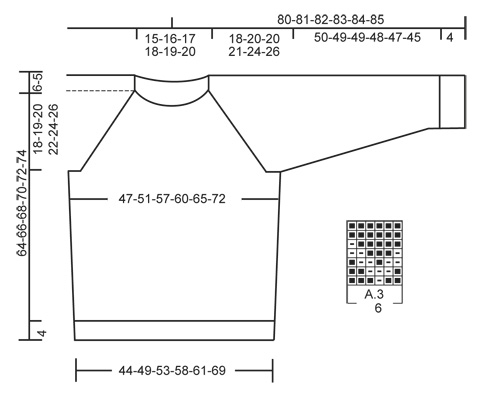 |
|||||||||||||
Have you finished this pattern?Tag your pictures with #dropspattern or submit them to the #dropsfan gallery. Do you need help with this pattern?You'll find 28 tutorial videos, a Comments/Questions area and more by visiting the pattern on garnstudio.com. © 1982-2025 DROPS Design A/S. We reserve all rights. This document, including all its sub-sections, has copyrights. Read more about what you can do with our patterns at the bottom of each pattern on our site. |
|||||||||||||







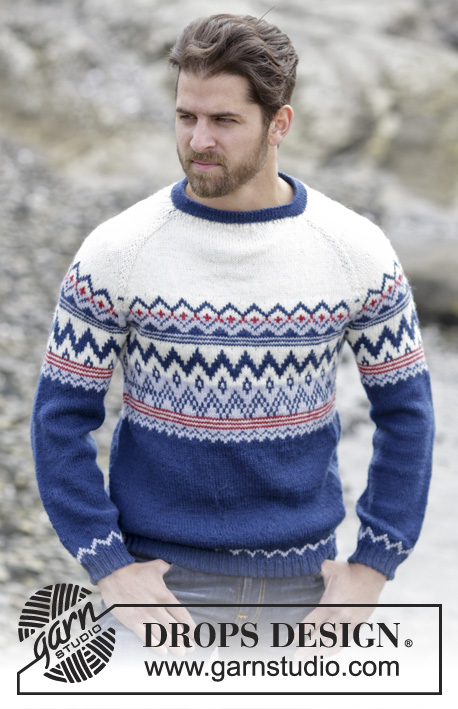
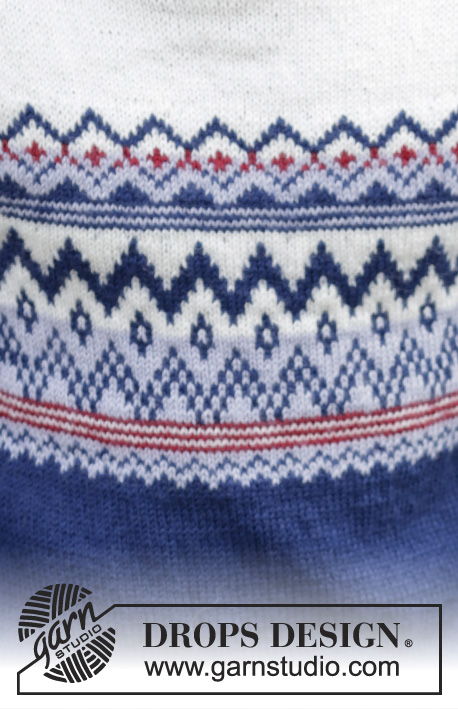
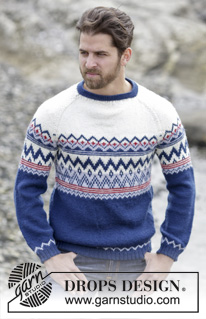


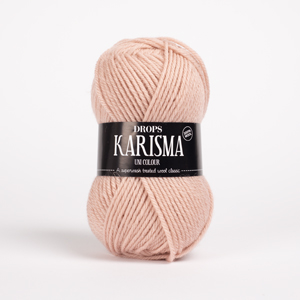


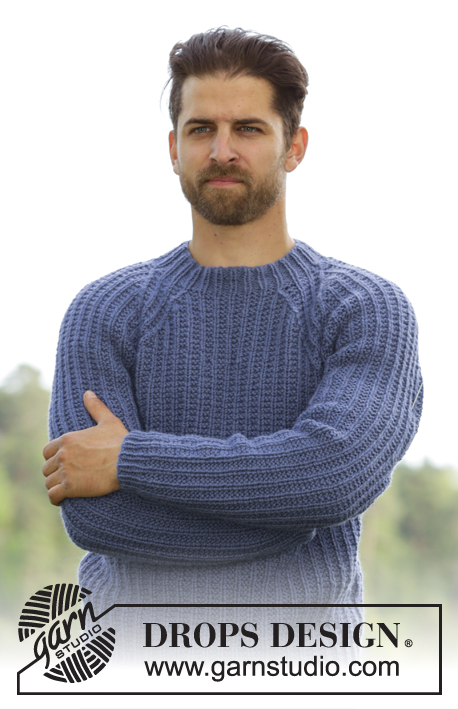






















































Post a comment to pattern DROPS Extra 0-1146
We would love to hear what you have to say about this pattern!
If you want to leave a question, please make sure you select the correct category in the form below, to speed up the answering process. Required fields are marked *.